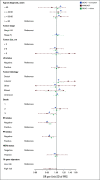Associations of a Breast Cancer Polygenic Risk Score With Tumor Characteristics and Survival
- PMID: 36689693
- PMCID: PMC10082287
- DOI: 10.1200/JCO.22.01978
Associations of a Breast Cancer Polygenic Risk Score With Tumor Characteristics and Survival
Abstract
Purpose: A polygenic risk score (PRS) consisting of 313 common genetic variants (PRS313) is associated with risk of breast cancer and contralateral breast cancer. This study aimed to evaluate the association of the PRS313 with clinicopathologic characteristics of, and survival following, breast cancer.
Methods: Women with invasive breast cancer were included, 98,397 of European ancestry and 12,920 of Asian ancestry, from the Breast Cancer Association Consortium (BCAC), and 683 women from the European MINDACT trial. Associations between PRS313 and clinicopathologic characteristics, including the 70-gene signature for MINDACT, were evaluated using logistic regression analyses. Associations of PRS313 (continuous, per standard deviation) with overall survival (OS) and breast cancer-specific survival (BCSS) were evaluated with Cox regression, adjusted for clinicopathologic characteristics and treatment.
Results: The PRS313 was associated with more favorable tumor characteristics. In BCAC, increasing PRS313 was associated with lower grade, hormone receptor-positive status, and smaller tumor size. In MINDACT, PRS313 was associated with a low risk 70-gene signature. In European women from BCAC, higher PRS313 was associated with better OS and BCSS: hazard ratio (HR) 0.96 (95% CI, 0.94 to 0.97) and 0.96 (95% CI, 0.94 to 0.98), but the association disappeared after adjustment for clinicopathologic characteristics (and treatment): OS HR, 1.01 (95% CI, 0.98 to 1.05) and BCSS HR, 1.02 (95% CI, 0.98 to 1.07). The results in MINDACT and Asian women from BCAC were consistent.
Conclusion: An increased PRS313 is associated with favorable tumor characteristics, but is not independently associated with prognosis. Thus, PRS313 has no role in the clinical management of primary breast cancer at the time of diagnosis. Nevertheless, breast cancer mortality rates will be higher for women with higher PRS313 as increasing PRS313 is associated with an increased risk of disease. This information is crucial for modeling effective stratified screening programs.
Conflict of interest statement
The following represents disclosure information provided by authors of this manuscript. All relationships are considered compensated unless otherwise noted. Relationships are self-held unless noted. I = Immediate Family Member, Inst = My Institution. Relationships may not relate to the subject matter of this manuscript. For more information about ASCO's conflict of interest policy, please refer to
Open Payments is a public database containing information reported by companies about payments made to US-licensed physicians (
No other potential conflicts of interest were reported.
Figures


References
Publication types
MeSH terms
Grants and funding
- R01 CA176785/CA/NCI NIH HHS/United States
- HHSN268201100004I/HL/NHLBI NIH HHS/United States
- C5047/A8384/CRUK_/Cancer Research UK/United Kingdom
- R01 CA128978/CA/NCI NIH HHS/United States
- R01 CA064277/CA/NCI NIH HHS/United States
- HHSN261201800015C/CA/NCI NIH HHS/United States
- HHSN268201100004C/WH/WHI NIH HHS/United States
- HHSN261201800009I/CA/NCI NIH HHS/United States
- R01 CA163353/CA/NCI NIH HHS/United States
- R03 CA130065/CA/NCI NIH HHS/United States
- UM1 CA164917/CA/NCI NIH HHS/United States
- U01 CA199277/CA/NCI NIH HHS/United States
- U01 CA179715/CA/NCI NIH HHS/United States
- R01 CA128931/CA/NCI NIH HHS/United States
- U54 CA156733/CA/NCI NIH HHS/United States
- HHSN261201800032C/CA/NCI NIH HHS/United States
- HHSN268201100001I/HL/NHLBI NIH HHS/United States
- HHSN261201800009C/CA/NCI NIH HHS/United States
- 203477/Z/16/Z/WT_/Wellcome Trust/United Kingdom
- UM1 CA164973/CA/NCI NIH HHS/United States
- P30 ES010126/ES/NIEHS NIH HHS/United States
- C8221/A19170/CRUK_/Cancer Research UK/United Kingdom
- NU58DP006344/DP/NCCDPHP CDC HHS/United States
- C1287/A10710/CRUK_/Cancer Research UK/United Kingdom
- P01 CA087969/CA/NCI NIH HHS/United States
- UM1 CA164920/CA/NCI NIH HHS/United States
- R01 CA097396/CA/NCI NIH HHS/United States
- UM1 CA176726/CA/NCI NIH HHS/United States
- R37 CA070867/CA/NCI NIH HHS/United States
- U01 CA176726/CA/NCI NIH HHS/United States
- R01 CA092447/CA/NCI NIH HHS/United States
- HHSN268201100046C/HL/NHLBI NIH HHS/United States
- C1287/A16563/CRUK_/Cancer Research UK/United Kingdom
- R01 CA058860/CA/NCI NIH HHS/United States
- C12292/A11174/CRUK_/Cancer Research UK/United Kingdom
- HHSN261201800015I/CA/NCI NIH HHS/United States
- K12 CA090628/CA/NCI NIH HHS/United States
- HHSN268201100003C/WH/WHI NIH HHS/United States
- G1000143/MRC_/Medical Research Council/United Kingdom
- C5047/A10692/CRUK_/Cancer Research UK/United Kingdom
- Z01 ES049030/ImNIH/Intramural NIH HHS/United States
- K07 CA092044/CA/NCI NIH HHS/United States
- HHSN261201800016C/CA/NCI NIH HHS/United States
- P50 CA058223/CA/NCI NIH HHS/United States
- R01 CA100374/CA/NCI NIH HHS/United States
- U19 CA148537/CA/NCI NIH HHS/United States
- C570/A16491/CRUK_/Cancer Research UK/United Kingdom
- R01 CA116167/CA/NCI NIH HHS/United States
- R01 CA148667/CA/NCI NIH HHS/United States
- R01 CA177150/CA/NCI NIH HHS/United States
- P50 CA116201/CA/NCI NIH HHS/United States
- HHSN271201100004C/AG/NIA NIH HHS/United States
- R01 CA063464/CA/NCI NIH HHS/United States
- HHSN261201800016I/CA/NCI NIH HHS/United States
- UM1 CA186107/CA/NCI NIH HHS/United States
- MR/M012190/1/MRC_/Medical Research Council/United Kingdom
- HHSN268201100002C/WH/WHI NIH HHS/United States
- C5047/A15007/CRUK_/Cancer Research UK/United Kingdom
- P30 CA023100/CA/NCI NIH HHS/United States
- U01 CA063464/CA/NCI NIH HHS/United States
- R01 CA077398/CA/NCI NIH HHS/United States
- R01 CA054281/CA/NCI NIH HHS/United States
- R01 CA132839/CA/NCI NIH HHS/United States
- P30 CA068485/CA/NCI NIH HHS/United States
- U01 CA058860/CA/NCI NIH HHS/United States
- U01 CA164920/CA/NCI NIH HHS/United States
- Z01 CP010119/ImNIH/Intramural NIH HHS/United States
- R35 CA253187/CA/NCI NIH HHS/United States
- U19 CA148112/CA/NCI NIH HHS/United States
- HHSN261201800032I/CA/NCI NIH HHS/United States
- U01 CA098758/CA/NCI NIH HHS/United States
- N01 CN025403/CA/NCI NIH HHS/United States
- U19 CA148065/CA/NCI NIH HHS/United States
- P30 CA033572/CA/NCI NIH HHS/United States
- HHSN268201100003I/HL/NHLBI NIH HHS/United States
- HHSN268201100002I/HL/NHLBI NIH HHS/United States
- C1281/A12014/CRUK_/Cancer Research UK/United Kingdom
- C8197/A16565/CRUK_/Cancer Research UK/United Kingdom
- R01 CA192393/CA/NCI NIH HHS/United States
- C1287/A10118/CRUK_/Cancer Research UK/United Kingdom
- R37 CA054281/CA/NCI NIH HHS/United States
- R01 CA120120/CA/NCI NIH HHS/United States
- HHSN268201100001C/WH/WHI NIH HHS/United States
- K24 CA169004/CA/NCI NIH HHS/United States
- U01 CA164973/CA/NCI NIH HHS/United States
- R01 CA140286/CA/NCI NIH HHS/United States

